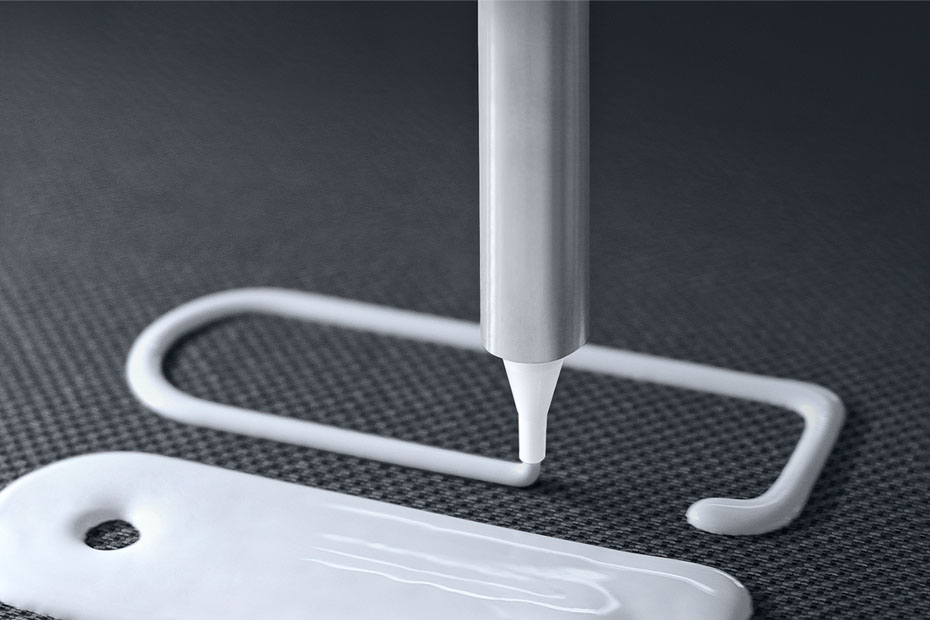Ostfildern-Kemnat, Germany. Additive manufacturing, also known as 3D printing, is already being used in many different industries – including textiles. Until now, photocuring polymers or silicone have often been used for such applications. However, polyurethane can also be used thanks to what’s known as “liquid additive manufacturing” (LAM). To this end, WEVO-CHEMIE GmbH has developed tailor-made reactive resins that improve both the processing conditions and the durability of the end products – from smart textiles to components for filtration technology or fuel cells.
Among other things, 3D printing offers greater freedom in design, enables existing functions of textiles and textile components to be optimised, as well as additional functions to be incorporated. Polyurethane reactive resins from Wevo also offer a number of additional advantages over the materials that have been predominantly used so far.
The use of polyurethane in additive manufacturing has been made possible by the LAM process. In this process, two reactive components are usually blended in a mixing and metering unit and applied directly to the textile to be printed by means of a print head. This step is performed without supporting structures, such as those used, for example, in stereolithography (SLA), the oldest additive manufacturing process. Wevo’s LAM products achieve the material properties necessary for the process by adding thixotropic additives to adjust the stability and the catalysts used to fine-tune the reaction times.
Another difference: no light source is needed to cure Wevo reactive resins, because the blend of resin and hardener components leads to the chemical reaction starting as soon as the mixture is dispensed by the print head. The exact curing time of the products – usually just a few minutes – is individually adjusted by adding catalysts. In addition, the time span can be shortened by using infrared (IR) lamps, also known as IR heaters.
Longer-lasting textile products due to improved adhesion and greater resistance
The chemical structures in polyurethanes are very similar to those in polyamide, polyester, polyacrylonitrile and elastane fibres. This results in the formation of hydrogen bonds, which ensure significantly better bonding of the material to the synthetic fibres compared with silicones. In addition, polyurethane wets the fibres well without penetrating them, making the textiles highly durable.
The choice of polyol components employed in the resin formulation of Wevo’s products and their combination with the right hardener components for the particular application also allows the products’ mechanical properties to be adjusted anywhere between very soft and elastic and very hard. This results in very good chemical resistance, for example to disinfectants and surfactants, such as those used in dry cleaning. A further modification of the materials enhances the hydrophobic, water-repellent properties of the textiles – for low water absorption and consequently improved washability.
New potential applications thanks to versatile polyurethane reactive resins
In addition to the mechanical properties, a wide range of other functions offered by these Wevo products can be tailored to individual requirements. These include flame-retardant properties for the manufacture of special textiles, protective clothing in particular, as well as a thermoregulating effect through the addition of phase-change materials (PCMs) or thermally conductive fillers. It is also possible to adjust electrically conductive and/or antistatic properties. This is of relevance to smart textiles, sensor applications or textile heating fabrics, such as seat heaters in cars.
The result is a multitude of potential applications that can be implemented thanks to Wevo products – whether it’s designer and decorative elements, structure reinforcements, textile impregnation or even the application of logos and lettering. It’s also possible to incorporate electrical and electronic components: for example, sensor and antenna elements can be manufactured using conductive adhesives and inks. These versatile Wevo products can also be used to encapsulate peripheral devices such as sensors, LEDs, batteries, power supply units or circuit boards to produce smart textiles. And in the field of membrane technology, the reactive resins can be used to seal and bond fibre mats, such as in the manufacture of nonwovens, enabling them to be used in filtration technology or in fuel cell components.
